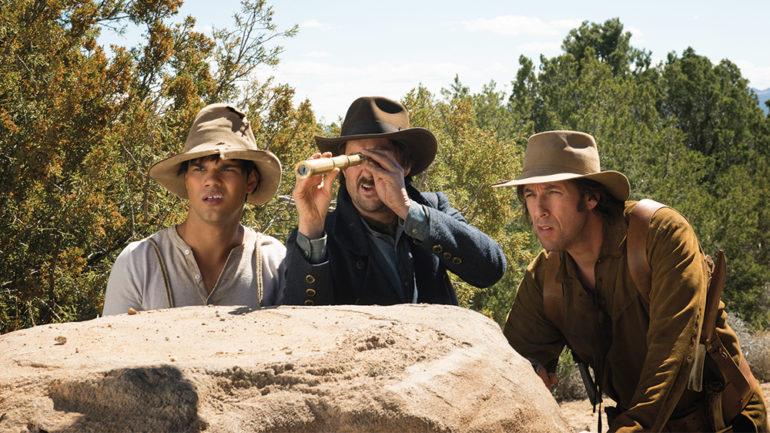Netflix Benefits From Changes in New Mexico’s Production Incentives
By Todd Longwell
LOS ANGELES (Variety.com) – When New Mexico’s new governor, Democrat Michelle Lujan Grisham, signed SB2 in late March, the headline was that it more than doubled the annual cap on the state’s 25%- to 30%-per-project refundable film and TV tax credit, from $50 million to $110 million.
Arguably more noteworthy, however, was the new law’s provision that the cap would not apply to companies that purchase or sign a 10-year lease for a qualified production facility. That’s good news for Netflix, which bought Albuquerque Studios in October and promised to make a total capital investment of $30 million in the facility and spend more than $1 billion to produce content there over the next decade. That means the deep-pocketed streamer — which has already shot a plethora of productions in , from the feature-length Adam Sandler Western spoof “The Ridiculous 6” to series such as “Longmire,” “Godless” and “Chambers” — can bring as many shows to the state as it wants, with no concern that its incentives would be limited by any cap.
It’s also good news for other New Mexico soundstage facilities like Santa Fe Studios, which flirted with foreclosure in 2016. Not only does it mean that no longer threatens to financially crowd out potential tenants, but it opens up the possibility of the studio getting its own long-term production partners.
“This is Netflix’s hub outside of Los Angeles, and we’re already in negotiations with two other companies to do the same thing,” says Alicia J. Keyes, the former head of the Albuquerque Film Office, who was tapped by the governor to serve as secretary of the Economic Development Department.
For New Mexico, it means more high-paying production jobs and increased economic diversity in a state with a small population (less than 2.1 million), a high poverty rate (19.7%, tied with Louisiana at No. 2 in the U.S.) and a narrow job market, where the primary employers are the state and federal governments and the oil and gas industry.
“We recognize that it’s a clean, burgeoning industry with tons of opportunity,” says Lujan Grisham of the entertainment business. “I’m really excited about [giving it] a full-on embrace.”
The message is quite different from the one sent by the governor’s predecessor, Republican Susana Martinez. When Martinez took office in 2011, she called the incentive “a subsidy to Hollywood on the backs of our schoolchildren” and vowed to cut the credit from 25% to 15%. In the end, she succeeded only in getting the legislature to put a $50 million rolling cap on the program, but its lack of certainty was enough to spook Hollywood, leading to a drop-off in production in the state, which had been booming with big-budget productions such as “The Avengers” and “Cowboys & Aliens” since the incentive went into effect in 2003.
“We experienced a really dry couple of years,” says Liz Pecos, who was recently elected president of IATSE Local 480 in Santa Fe. “We had a lot of members during that period who had to move away to Atlanta and other places because there just wasn’t enough consistent work.”
The industry’s faith in New Mexico’s commitment to the incentive was largely restored in 2013, when Martinez signed the so-called “Breaking Bad” bill, giving TV pilots and series that film at least six episodes in the state — and with a budget of at least $50,000 each — an extra 5% tax credit. The state still had the rolling cap, which had created a backlog of $382 million in unpaid tax credits as of 2019, but that too has been mitigated by the passage of SB2, which will pay off $225 million of those unpaid tax credits and cap future backlogs at $100 million.
The passage of SB2 will also bring more fiscal transparency from the state, including a monthly reporting of the amount of tax credits paid and claimed for the fiscal year. And it grants an additional 5% to productions that shoot in rural areas, defined as 60 miles outside the counties of Bernalillo (home to Albuquerque) and Santa Fe. This is good news for the state’s second-most populous city, Las Cruces, where portions of Clint Eastwood’s “The Mule” were shot, and a former Coca-Cola bottling plant is being turned into a soundstage facility.
But no matter how many productions shoot in New Mexico in the coming years, it will probably never be as busy as Los Angeles. That’s OK with SAG-
AFTRA New Mexico local president Marc Comstock, who moved from Hollywood to the Land of Enchantment in 2011. “We have five casting directors, and it’s much easier to establish relationships and get into rooms as opposed to the hundreds you have in L.A.,” Comstock notes. “And I’ll never complain about traffic in New Mexico.”

